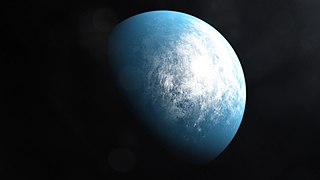
Transiting Exoplanet Survey Satellite (TESS) is a space telescope for NASA's Explorer program, designed to search for exoplanets using the transit method in an area 400 times larger than that covered by the Kepler mission. It was launched on 18 April 2018, atop a Falcon 9 launch vehicle and was placed into a highly elliptical 13.70-day orbit around the Earth. The first light image from TESS was taken on 7 August 2018, and released publicly on 17 September 2018.

Planet Hunters is a citizen science project to find exoplanets using human eyes. It does this by having users analyze data from the NASA Kepler space telescope and the NASA Transiting Exoplanet Survey Satellite. It was launched by a team led by Debra Fischer at Yale University, as part of the Zooniverse project.

Disk Detective is the first NASA-led and funded-collaboration project with Zooniverse. It is NASA's largest crowdsourcing citizen science project aiming at engaging the general public in search of stars, which are surrounded by dust-rich circumstellar disks, where planets usually dwell and are formed. Initially launched by NASA Citizen Science Officer, Marc Kuchner, the principal investigation of the project was turned over to Steven Silverberg.

Kepler-1647b is a circumbinary exoplanet that orbits the binary star system Kepler-1647, located 3,700 light-years (1,100 pc) from Earth in the constellation Cygnus. It was announced on June 13, 2016, in San Diego at a meeting of the American Astronomical Society. It was detected using the transit method, when it caused the dimming of the primary star, and then again of the secondary star blended with the primary star eclipse. The first transit of the planet was identified in 2012, but at the time the single event was not enough to rule out contamination, or confirm it as a planet. It was discovered by the analysis of the Kepler light-curve, which showed the planet in transit.
TOI-700 is a red dwarf 101.4 light-years away from Earth located in the Dorado constellation that hosts TOI-700 d, the first Earth-sized exoplanet in the habitable zone discovered by the Transiting Exoplanet Survey Satellite (TESS).

TOI-700 d is a near-Earth-sized exoplanet, likely rocky, orbiting within the habitable zone of the red dwarf TOI-700, the outermost planet within the system. It is located roughly 101.4 light-years (31.1 pc) away from Earth in the constellation of Dorado. The exoplanet is the first Earth-sized exoplanet in the habitable zone discovered by the Transiting Exoplanet Survey Satellite (TESS).

TOI-1338 is a binary star system located in the constellation Pictor, about 1,320 light-years from Earth. It is orbited by two known circumbinary planets, TOI-1338 b, discovered by the Transiting Exoplanet Survey Satellite (TESS) and BEBOP-1c, discovered by the Binaries Escorted By Orbiting Planets project.
A Peter Pan disk is a circumstellar disk around a star or brown dwarf that appears to have retained enough gas to form a gas giant planet for much longer than the typically assumed gas dispersal timescale of approximately 5 million years. Several examples of such disks have been observed to orbit stars with spectral types of M or later. The presence of gas around these disks has generally been inferred from the total amount of radiation emitted from the disk at infrared wavelengths, and/or spectroscopic signatures of hydrogen accreting onto the star. To fit one specific definition of a Peter Pan disk, the source needs to have an infrared "color" of , an age of >20 Myr and spectroscopic evidence of accretion.

L 98-59 b is an exoplanet having a size between that of the Earth and Mars and a mass only half that of Venus. It orbits L 98-59, a red dwarf 35 light-years away in the constellation Volans. There are at least 3 other planets in the system: L 98-59 c, d, e, and the unconfirmed L 98-59 f. Its discovery was announced on 27 June 2019 on the NASA website. It was the smallest planet discovered by TESS until the discovery of LHS 1678b, and was the lowest-mass planet whose mass has been measured using radial velocities until Proxima Centauri d was found in 2022.
L 98-59 is a bright M dwarf star, located in the constellation of Volans, at a distance of 10.608 parsecs, as measured by the Gaia spacecraft.
TOI-1452 b is a confirmed super-Earth exoplanet, possibly a water world, orbiting a red-dwarf star TOI-1452 about 100 light-years away in the Draco constellation. The exoplanet is about 70% larger in diameter than Earth, and roughly five times as massive.

TOI-700 e is the second outermost known exoplanet orbiting TOI-700, a red dwarf star in the constellation of Dorado.
TOI-813 is a bright subgiant G-type star located 858 light-years away from planet Earth. It is too faint to be seen with the naked eye. TOI-813 has a mass of 1.32 solar masses, a radius of 1.95 solar radii and a luminosity of 4.3 times the solar luminosity.








